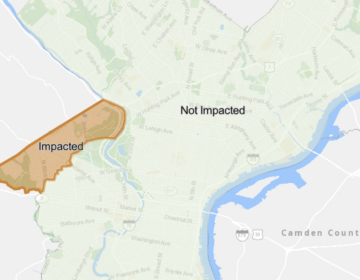Toxic chemical in Bellmawr well topped N.J. health limit for a year, officials say
Residents of Bellmawr spent the last year drinking water from a public well that was contaminated by a toxic chemical at levels beyond state health limits.

(Bigstock/Snowboy)
This article originally appeared on NJ Spotlight.
—
Residents of Bellmawr spent the last year drinking water from a public well that was contaminated by a toxic chemical at levels beyond state health limits, the mayor of the Camden County town said.
Mayor Charles Sauter sent a letter to homeowners Wednesday saying that tests in August on one of the town’s two wells detected perfluorooctanoic acid (PFNA) — one of the PFAS family of chemicals — at 19 parts per trillion (ppt), exceeding the state’s Maximum Contaminant Limit of 13 ppt.
Sauter’s letter said the average level of PFNA over the last year at the Warren Avenue well has been 19 ppt, while the community’s other well, known as Leaf & Bell, showed the chemical within the limit set by the state Department of Environmental Protection.
The water sample that exceeded the health limit was taken on Aug. 13, and the results were communicated to the borough by the DEP on Sept. 26, the Mayor’s letter said.
“In an abundance of caution,” the Borough of Bellmawr has ordered the Warren Avenue well shut down until more tests are done and a permanent solution to the contamination can be found, the letter said. Meanwhile, all customers are being supplied from the Leaf & Bell well, and their water supply will not be interrupted.
“This is not an emergency. If it had been, you would have been notified with 24 hours,” Sauter wrote.
Health risks associated with chemical
He said residents don’t need to boil water or take other corrective actions, but warned that infants, the elderly, pregnant women or those with severely compromised immune systems who drank water from the tainted well may be at increased risk, and should seek medical advice about the best sources of drinking water.
Sauter wrote that people who have drunk water containing the chemical at above the state MCL for many years could experience problems with liver, kidney, immune or reproductive systems. Children born to women with long-term exposure to PFNA may experience developmental delays, he said.
The federal EPA says exposure to different kinds of PFAS chemicals can lead to cancer (in the case of PFOA), thyroid hormone disruption (for PFOS), as well as low birth weights and immune system effects.
Borough officials did not return calls seeking comment on why the public was not informed sooner, why the average PFNA level in the well exceeded the health limit for the last year, or how they plan to resolve the contamination.
The DEP, which has become a national leader in regulating PFAS chemicals, adopted the PFNA limit in 2018 after state and federal surveys showed the chemicals in many New Jersey water systems. In 2014, the DEP reported that 10 kinds of PFAS chemicals were found in two-thirds of 33 water systems tested across the state. The department is now in the process of adopting strict limits on PFOA (perfluorooctanoic acid) and PFOS (perfluorooctane sulfonate).
Contamination also found nearby
In 2013, PFNA was found in the South Jersey town of Paulsboro at 150 ppt, more than 10 times the state limit, and more than twice the benchmark recommended, but not required, by the EPA .
PFNA and other PFAS chemicals are known as “forever chemicals” because they do not break down in the environment, and persist in some water systems long after their industrial use has ended.
Different kinds of PFAS chemicals were used in consumer products including nonstick cookware and flame-resistant fabrics, starting in the 1940s. Their use has been phased out by U.S. manufacturers but they may still be able to enter the United States in goods imported from countries that still use or make them.
In response to the Bellmawr contamination, the DEP sent a non-compliance letter to the town’s water department in late September, requiring it to notify the public; report to DEP on how it plans to bring the water system back into compliance with the health limit, and to make the changes within a year.
Jeff Tittel, director of the New Jersey Sierra Club, said the DEP should ensure that Bellmawr residents have clean water to drink, and should investigate the source of the contamination.
“The fact that Bellmawr’s drinking water has exceeded safe drinking standards for PFNA should be an alarm bell going off,” he said.
The federal Agency for Toxic Substances and Disease Registry said in 2013 that PFNA contamination detected in Paulsboro “may” have been caused by Solvay Specialty Polymers, a chemical manufacturer in nearby West Deptford, which stopped using the toxic compound in 2010.
Tittel noted Bellmawr is only eight miles away from West Deptford.
Company denies responsibility
Solvay spokesman David Klucsik said the company has been doing a “remedial investigation” of PFAS chemicals near its West Deptford location for about six years, and has sent the results to the DEP.
But he denied any link between PFNA contamination near the Solvay facility, and that found in Bellmawr.
“There is no evidence to suggest that the plant’s former use of PFNA could impact water supplies as far away as the Borough of Bellmawr,” he said.
Even though DEP has found elevated levels of PFNA at some sites, it has made “no assertion” that Solvay has been responsible, Klucsik said. He added that the company’s investigation has found “many” other potential sources of PFAS in Gloucester County and throughout New Jersey, including those between Solvay’s West Deptford plant and Bellmawr.
The company’s remediation has included providing bottled water to residents in some areas, and capping contaminated soil around its factory “to mitigate impacts from onsite PFAS-impacted soils,” he said.
WHYY is your source for fact-based, in-depth journalism and information. As a nonprofit organization, we rely on financial support from readers like you. Please give today.




